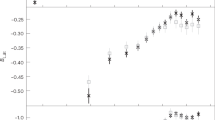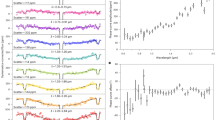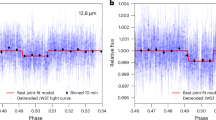Abstract
THE variation of brightness as a function of height when a meteoroid burns up (ablates) in the Earth's atmosphere is governed by the physical properties of the meteoroid. The basic theory of the ablation of a solid meteoroid to due to Öpik1, and the theoretical light curves are in fairly good agreement with the observed light-curves of very bright meteors2. In contrast to this the observations of Jacchia3 and Hawkins and Southworth4 of faint photographic meteors show that the train lengths of these meteors are much shorter than predicted by the classical theory, and it is principally due to evidence of this sort that the “dustball” theory of Whipple5 which supposes the original meteoroid to consist of an aggregate of many small solid particles, has become very popular. Nevertheless Jones and Kaiser6 found that by extending the classical ablation theory to include the effects of the meteoroid's thermal capacity, conduction and radiation they could explain many features of the experimental data in terms of compact meteoroids which fragment as a result of thermal shock. According to Jones and Kaiser6 it is possible to choose between the two theories on the basis of observations of very faint meteors (magnitude M > + 3) since these meteoroids should not fragment due to thermal shock if they are compact; on the other hand if they are fragile conglomerates they will probably continue to show the effects of severe disintegration.
Similar content being viewed by others
Article PDF
References
Öpik, E., Publs. astr. Obs. Tartu, 29 (5) (1937).
McKinley, D. W. R., Meteor Science and Engineering, 138 (McGraw-Hill, New York, 1961).
Jacchia, L. G., Astrophys. J., 121, 521 (1955).
Hawkins, G. S., and Southworth, R. B., Smithson. Contr. Astrophys., 349 (1958).
Whipple, F. L., IAU Symp. No. 4 (edit. by Van der Hulst, H. C.), 375 (Cambridge University Press, 1957).
Jones, J., and Kaiser, T. R., Mon. Not. R. astr. Soc., 133, 411 (1966).
Hawkes, R. L., and Jones, J., Observatory, 93, 233 (1973).
Author information
Authors and Affiliations
Rights and permissions
About this article
Cite this article
JONES, J., HAWKES, R. Light curves of very faint meteors. Nature 248, 211 (1974). https://doi.org/10.1038/248211a0
Received:
Issue date:
DOI: https://doi.org/10.1038/248211a0
This article is cited by
-
Genetic control of in vitro response in wheat (Triticum aestivum L.)
In Vitro Cellular & Developmental Biology - Plant (2001)



